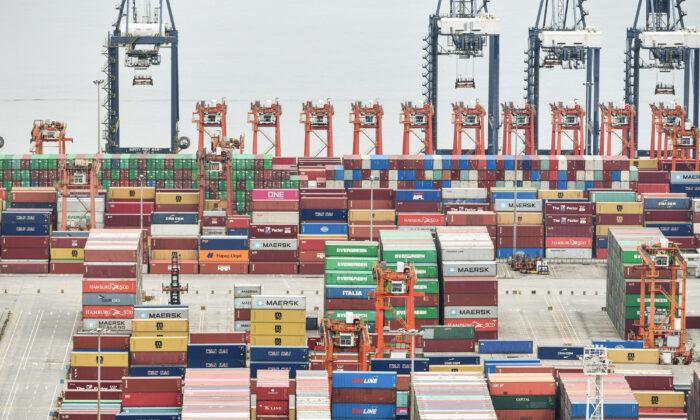Exports from China, the world’s second-largest economy, fell in May for the first time in three months amid waning global demand for Chinese goods.
Data published on June 7 by China’s General Administration of Customs showed that exports, which serve as the main source of foreign exchange for China, fell 7.5 percent year over year, to $283.5 billion, marking the biggest decline since January and reversing April’s unexpectedly strong 8.5 percent growth.
Those figures also mark a significantly worse decline than the 0.4 percent predicted by a Reuters poll.
Double-digit declines were seen in exports to most countries, including the United States, Japan, France, Italy, and nations in Southeast Asia, Bloomberg reports, most likely in part due to Federal Reserve inflation hikes meant to tackle inflation that are in return cooling off demand.
Exports to the United States, where tensions with China have grown increasingly strained due to the ruling Chinese Communist Party’s actions toward Taiwan, were down 18.2 percent alone from a year earlier, to $42.5 billion, the data showed.
Imports also fell, albeit, at a slightly slower pace amid declining domestic demand, the data showed. Imports contracted 4.5 percent, to $217.7 billion, moderating from April’s 7.9 percent year-over-year contraction. Economists at Reuters had forecasted an 8 percent fall in imports.
China Must ‘Rely on Domestic Demand’
As a result, China’s monthly global trade surplus dropped down 16.1 percent, to $65.8 billion, well below expectations, while its trade surplus with the United States narrowed by 21.9 percent, to $28.1 billion.“The weak exports confirm that China needs to rely on domestic demand as the global economy slows,” Zhiwei Zhang, chief economist at Pinpoint Asset Management, told Reuters. “There is more pressure for the government to boost domestic consumption in the rest of the year, as global demand will likely weaken further in the second half.”
The latest data do not bode well for China, which appears to be recovering much slower than anticipated in the wake of stringent COVID-19 lockdowns being lifted.
The official Purchasing Managers’ Index showed last week that factory activity in May shrank to its weakest level since the country scrapped its zero-COVID policy in December, dropping to 48.8, down from 49.2 in April.
Meanwhile, retail spending is recovering at a slower pace than anticipated amid concern over the volatile economy, and the retail market has been on the decline, with prices up but sales down, according to a May report from the U.S.-based China Beige Book.
China and Russia Bolstering Imports, Exports
Inflation in China reportedly stood at 0.1 percent in April, with May’s data set to be released on Friday.The government has set a gross domestic product growth (GDP) target of around 5 percent for this year, after recording 3 percent GDP in 2022, its second-lowest rate in decades.
While imports and exports to and from most nations slowed in May, imports from Russia rose 10 percent over a year ago, to $11.3 billion, and consisted mainly of oil and gas.
China has been purchasing more Russian energy amid price cuts, which it can do without triggering Western sanctions, despite being criticized by the West for indirectly supporting the sanction-hit nation amid its invasion of Ukraine.
Exports to Russia, meanwhile, were up 114 percent year over year, to $9.3 billion.
Russia has declared a “friendship without limits” with China, with trade between the two nations expected to reach $200 billion this year, according to Russian prime minister Mikhail Mishustin.





